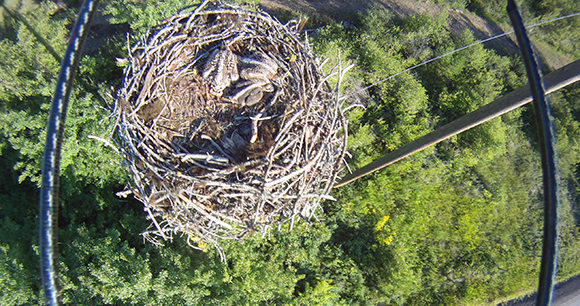by James Junda and Dr. David Bird
Surveying nesting raptors provides important information on population productivity. Since raptors occupy spots near the top of the food web, they are also often good indicators of ecosystem health. But surveying raptor nests using traditional methods requires climbing to the nest or flying over it in a small airplane or helicopter. While useful, both of these survey methods cause significant disturbance to nesting birds, not to mention posing a serious risk of injury or death to biologists. Thus, our aim was to reduce the disturbance to nesting birds, while maintaining the accuracy of the surveys.

Unmanned Aerial Vehicles (UAVs), or “drones,” offer a viable alternative to traditional technologies for a wide variety of data collection tasks, but little work has been done investigating the response of wildlife to these devices. Our study assessed the use of a Draganflyer X-4 rotary-winged quad-copter mounted with a camera to safely and accurately census the nest contents of four raptor species: osprey (Pandion haliaetus), bald eagle (Haliaeetus leucocephalus), ferruginous hawk (Buteo regalis), and red-tailed hawk (B. jamaicensis).
Using generous support from AWI’s Christine Stevens Wildlife Award, we were able to fly 24 nest surveys in Saskatchewan, Canada. Between June 21 and July 6, 2014, we completed UAV surveys of bald eagles (8 nests), ferruginous hawks (11 nests), and red-tailed hawks (5 nests), with each survey taking place when feathered nestlings were present in the nests. We obtained a nest image in 7 of 8 flights over bald eagle nests, 10 of 11 over ferruginous hawk nests, and 3 of 5 over red-tailed hawk nests. These surveys, combined with the total of 86 nest survey flights over osprey nests performed in Missoula, Montana, in the summer of 2013, comprised our field research.
Over three nesting seasons, the UAVs flew surveys over more than 100 raptor nests and, in most situations, performed as required and without incident. This technique can be readily adapted to a variety of habitat types and species. The success in obtaining data combined with the reduction of safety risks and obtrusiveness associated with using manned aircraft, bucket trucks, or climbing to nests to count eggs or young illustrates the benefits and suitability of these machines to survey nests. To maximize success, it is critical that proper flight technique, taking into account bird and human safety, is adopted, practiced, and executed.
Additionally, through intense behavioral documentation and analysis, we have shown that UAVs do not cause high levels of disturbance to the nesting raptors in our study. Based on our findings, UAVs represent an effective and adaptable tool for safely surveying raptor nests and may be appropriate for use by other researchers.
James Junda is an MS candidate at McGill University, Department of Natural Resource Sciences—Wildlife Biology. He has 10 years of experience safely collecting data on avian conservation projects across the globe. He is the director of the Monomoy Refuge Banding Station.
Dr. David Bird is founding editor of the Journal of Unmanned Vehicle Systems. He has over 40 years of experience with raptor biology as a professor of wildlife biology at McGill University.